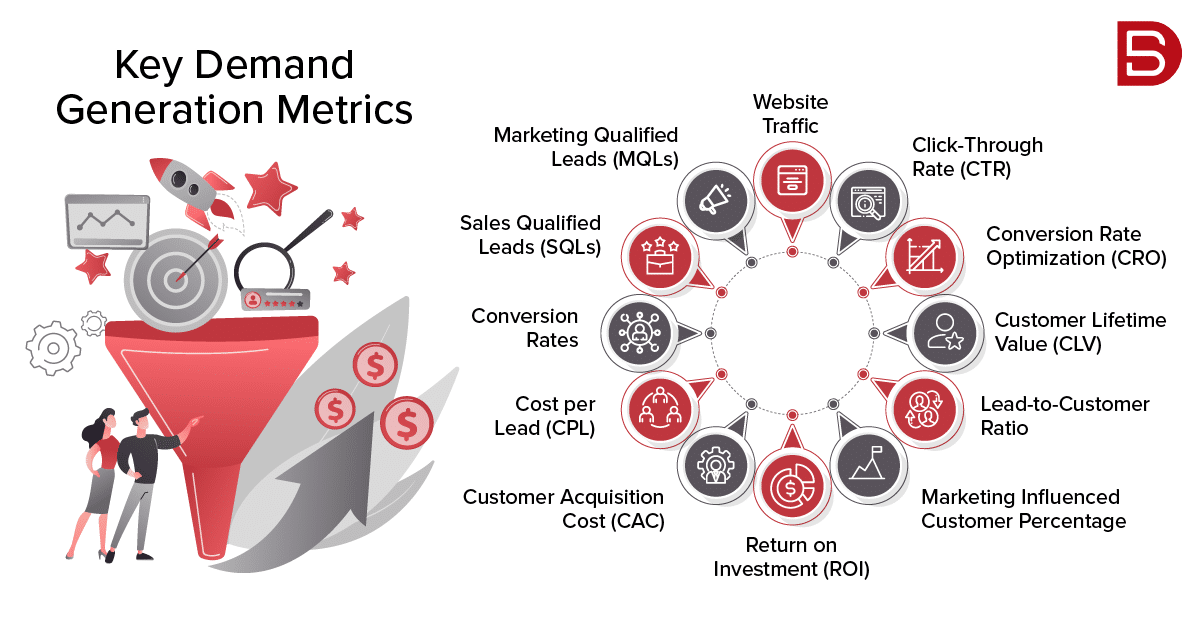Table of Contents
Introduction
For any marketer, generating leads and traffic remains the biggest challenge, despite all the advent in technology and channels to market. According to a recent study by HubSpot, “63% of marketers say generating traffic and leads is their top marketing challenge.” Every modern B2B firm has enormous funds allocated to marketing and demand generation; however, few can achieve the desired demand generation rates.
While it’s tough to pinpoint the exact cause behind the poor demand generation outcomes for a specific organization, the “lack of data and inability to analyze key demand generation metrics certainly will rank higher among the most common causes.
In this blog, we will discuss those demand generation metrics to understand what they are, why they are essential for modern businesses, and how businesses can leverage them to boost their demand generation ROI. So, let’s start by understanding what demand generation metrics are.
Simply put, demand generation metrics are the key performance indicators (KPIs) that every business track to measure the success or effectiveness of their demand generation campaigns. These metrics are good indicators of the effectiveness of your marketing and sales process.
Thus, they help businesses understand how effectively they generate leads, attract interest, and convert prospects into customers. For all of those reasons, these demand generation metrics hold great importance for any business and must always be taken seriously.
Key Demand Generation Metrics
For any business, demand generation metrics are the key performance indicators (KPIs) for measuring the effectiveness of their demand generation efforts. These metrics help businesses have a deeper look into their marketing and sales processes. As a result, businesses can understand what’s working for them in generating interest, attracting leads, and eventually converting those leads into paying customers.
Some key demand generation metrics that every business track include:
- Marketing Qualified Leads (MQLs)
- Sales Qualified Leads (SQLs)
- Conversion Rates
- Cost per Lead (CPL)
- Customer Acquisition Cost (CAC)
- Return on Investment (ROI)
- Website Traffic
- Click-Through Rate (CTR)
- Conversion Rate Optimization (CRO)
- Customer Lifetime Value (CLV)
- Lead-to-Customer Ratio
- Marketing Influenced Customer Percentage
These demand generation metrics, along with some others give useful insights into the effectiveness of a business’s demand generation strategies, which allows the business to make data-driven decisions, optimize their marketing campaigns, and attain sustainable growth.
How To Track and Measure Demand Generation Metrics
You need a systematic approach for tracking and measuring your demand generation metrics. It will not only help you analyze the data thoroughly but also give you insights into optimizing your marketing efforts.
Here we have listed some best practices for effectively tracking and measuring demand generation metrics:
• Create Clear Goals and Objectives
When setting up your demand generation efforts, ensure you have clearly defined goals and objectives for each effort. These goals and objectives can be lowering customer acquisition costs, improving conversion rates, or growing the number of leads you generate. These goals and objectives will allow you to establish which metrics to track and measure.
• Identify the Right Metrics
Depending upon the business or industry, you can have different metrics to track. Thus, it is imperative to identify the metrics that best align with your objectives and goals. The most commonly tracked and measured metrics include MQLs, conversion rates, SQLs, CPL, CAC, ROI, and CLV. Based on your business priorities, you can choose any of the metrics.
• Leverage Analytics and Tracking Tools
There are plenty of helpful analytics and tracking tools, such as Google Analytics, CRM systems, marketing automation platforms, and marketing automation software, that can help you track and measure your demand generation metrics. To capture data effectively, you must set up a robust tracking system using UTM parameters, event tracking, and conversion tracking.
• Analyze and Interpret Data
Collecting data is only helpful if you analyze it properly. Analyzing data will give you the insights needed to analyze your demand generation campaigns’ performance objectively. It will also help you identify the patterns and trends that are working for you or not working for you. You can use this information to tweak your efforts as and when needed.
By following these steps for tracking and measuring your demand generation metrics, you will get the valuable insights needed for optimizing your marketing efforts and consequently driving business growth.
The Impact of Demand Generation Metrics on Business Success
Demand generation metrics are critical in determining any business’s success. These metrics provide businesses with valuable insights into the performance of their marketing strategies and allow them to make informed business decisions. While there are many ways in which these metrics impact the success of any business, here are some key ways that we feel are vital:
• Identifying The Right Marketing Channels
Demand generation metrics allow the business to identify the most effective marketing channel for them. It provides them with helpful information on which campaigns generate the most leads. By analyzing metrics like click-through rates, conversion rates, and cost per lead, businesses can tweak their marketing strategies accordingly to get the maximum out of their campaigns.
• Optimizing Campaigns and Strategies
By analyzing the demand generation metrics, businesses can easily track the performance of their various marketing campaigns and optimize them for maximum gains. Monitoring metrics such as customer acquisition costs, conversion rates, and ROI can serve as critical indicators of underperforming campaigns and those that need optimization.
• Better Sales and Marketing Alignment
Demand generation metrics can significantly boost the sales and marketing team alignment by providing them with valuable insights to work with. Metrics like marketing qualified leads (MQLs) and sales qualified leads (SQLs) can improve the collaboration between the two teams and significantly improve lead handoff, lead nurturing, and conversion rates.
• Identifying Growth Opportunities
The insights derived from demand generation metrics can help businesses identify and tap into potential growth opportunities. Metrics such as customer lifetime value (CLV) and lead-to-customer ratio can help businesses identify high-value customer segments and tweak their strategies accordingly. It also allows them to focus on retaining and acquiring customers with the potential for long-term profitability.
Overall, demand generation metrics give a comprehensive overview of the performance of a business’s marketing efforts and, consequently, the growth opportunities. These metrics can be leveraged for not only optimizing your marketing efforts but also for identifying growth opportunities and improving the alignment between the sales and marketing teams.
Conclusion
In the modern, fast-paced business environment where everything is driven by data, strategically analyzing demand generation metrics can help a business optimize its marketing efforts, boost conversions, lower customer acquisition cost, and achieve sustainable growth. If you are a sales leader looking for an effective demand generation strategy at your organization, we have the tools and resources to help you get started. Just write to us at: [email protected], and we will have our demand gen experts reach out to you with a solution tailored to meet your needs.


